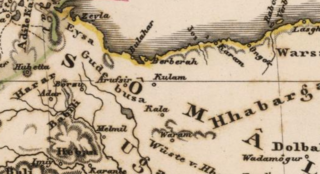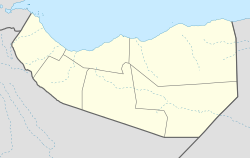
Marodi Jeh is an administrative region (gobol) in western Somaliland. It is the most populous region of the country. It is bordered by Awdal to the west, Sahil to the north, Togdheer to the east and Ethiopia to the south. Marodi Jeh was created by splitting the previously existing region (gobolka) Woqooyi Galbeed in two, the other part being Sahil. In 2007 the region of Woqooyi Galbeed was renamed to Maroodi Jeex. Woqooyi Galbeed was thus much larger than Marodi Jeh.
The Habar Yoonis alternatively spelled as Habr Yunis is a major clan part of the sub-clan Garhajis of the wider Isaaq. As descendants of Ismail bin Sheikh Isaaq, its members form a part of the wider Habar Magaadle confederation which constitutes the largest sub-clan of the Isaaq.
The Arap or Arab clan is a major clan of the wider Isaaq clan family and is the twin of Garhajis (Ismail), according to the clan genealogy. The Arap predominantly live on the middle and southwest side of Hargeisa and in the Baligubadle district of Somaliland, with its capital Baligubadle being an exclusively Arap territory. The territory of the clan extends to Ethiopia, in the area of Baligubadle. The Abdalle Arap, a sub-clan of the Arap clan is based in the Togdheer, Sool Hargeisa and Sahil regions.
The Eidagale (Ciidagale), is a major Somali clan and is a sub-division of the Garhajis clan of the Isaaq clan family. Members of this clan are concentrated in the western portions of Somaliland and the Somali region of Ethiopia. The Eidagale are part of the four principal clans of the Isaaq clan family. They are the traditional holders of the Isaaq Sultanate since the 18th century. As descendants of Ismail bin Sheikh Isaaq, its members form a part of the Habar Magaadle confederation, and they constitute the largest sub-clan of the Isaaq. They are traditionally nomadic pastoralists, merchants and skilled poets.

The Isaaq is an ethnic group in Somaliland. It is one of the major tribes in the Horn of Africa, with a large and densely populated traditional territories.
The Garhajis historically known as the Habar Gerhajis is a major clan of the wider Isaaq clan family. They are the traditional holders of the Isaaq Sultanate and Habr Yunis Sultanate since the 18th century. As descendants of Ismail bin Sheikh Isaaq, its members form a part of the Habar Magaadle confederation, and they constitute the largest sub-clan of the Isaaq. The Garhajis are divided into two major sub-clans: the Habr Yunis and Eidagale. They are traditionally nomadic pastoralists, merchants and skilled poets.
The Habr Awal, also contemporarily known as the Subeer Awal, and alternately romanized as the Zubeyr Awal is a major clan of the wider Isaaq clan family, and is further divided into eight sub-clans of whom the two largest and most prominent are the Sa'ad Musa and Issa Musa sub-clans. Its members form a part of the Habr Magaadle confederation. The Habr Awal traditionally consists of nomadic pastoralists, coastal people, merchants and farmers. They are historically viewed as an affluent clan relative to other Somali clans. The Habr Awal are politically and economically influential in present-day Somaliland, and reside in strategic coastal and fertile lands.
The Reer Nuur also known as Nuur Yoonis, is a noble northern Somali clan, a sub-division of the Makahiil sub-clan of the Gadabursi clan family.
Sultan Deria Hassan was a Somali ruler. He was the fourth Grand Sultan of the Isaaq Sultanate and known as a shrewd and wise leader.
Deria Sugulle Ainanshe was a Somali ruler and the 2nd Sultan of the Habr Yunis Sultanate, reigning from the late-eighteenth to the mid-nineteenth century.
Sultan Farah Guled was a Somali ruler. He was the second Grand Sultan of the Isaaq Sultanate and also a Hajji having completed pilgrimage to Mecca.
Sultan Hassan Farah (Somali: Xasan Faarax, Arabic: حسن بن فارح was a Somali ruler. He was the third Grand Sultan of the Isaaq Sultanate
Sultan Guled Abdi was a Somali ruler. He was the first Sultan of the Isaaq Sultanate and his numerous offspring would form the Rer Guled and continue to lead after his death.

Hussein Hasan was a famous Somali poet and warrior of the Eidagale Isaaq clan known for his skills in battle and hot temper.

The Isaaq Sultanate was a Somali kingdom that ruled parts of the Horn of Africa during the 18th and 19th centuries. It spanned the territories of the Isaaq clan in modern-day Somaliland and Ethiopia. The sultanate was governed by the Rer Guled branch of the Eidagale clan and is the pre-colonial predecessor to the modern Republic of Somaliland.

The Habr Yunis Sultanate was a Somali kingdom that ruled parts of the Horn of Africa during the 18th century. It spanned the territories of the Habr Yunis clan which is part of the wider Isaaq in modern day Somaliland and Ethiopia. The sultanate was governed by the Rer Ainanshe branch of the Habr Yunis clan.
The Rer Ainanshe are a royal Somali clan and the traditional rulers of the Habr Yunis. They divide into 17 major sub-clans that together form the Baha Ainanshe and Rer Sugulle, from the latter descend the rulers of the Habr Yunis Sultanate. They inhabit the Togdheer and Maroodi Jeex regions of Somaliland and the Daroor, Danot and Misraq Gashamo regions of Ethiopia

Sheikh Ishaaq bin Ahmed bin Muhammad bin al-Hussein al-Hashimi, more commonly known as Sheikh Ishaaq or Sheikh Isaaq was the Sayyid forefather of the Somali Isaaq clan-family in the Horn of Africa, whose traditional territory is wide and densely populated.
The Sa'ad Musa or Saad Musa is a northern Somali clan. Its members form a part of the Habr Awal clan of the Isaaq clan family. The Sa'ad Musa traditionally consists of nomadic pastoralists, coastal people, merchants and farmers. The clan inhabits Somaliland, including Maroodi Jeex, and Sahil as well as Djibouti, the Somali Region of Ethiopia and Kenya.

House of Guled was the ruling house of the Isaaq Sultanate from 1750 to 1884 and is also a subclan in its own right. The family are descendants of the Eidagale sub division of the wider Garhajis and in extension Isaaq clan-family. Although they no longer hold any authority, they are the royal house of Somaliland and are viewed as a favoured symbol in the country. In July 2021, Sultan Mahamed Abdiqadir had a state funeral with nationwide media coverage and was attended by high government officials, including the president of Somaliland; Muse Bihi Abdi and foreign dignitaries.








